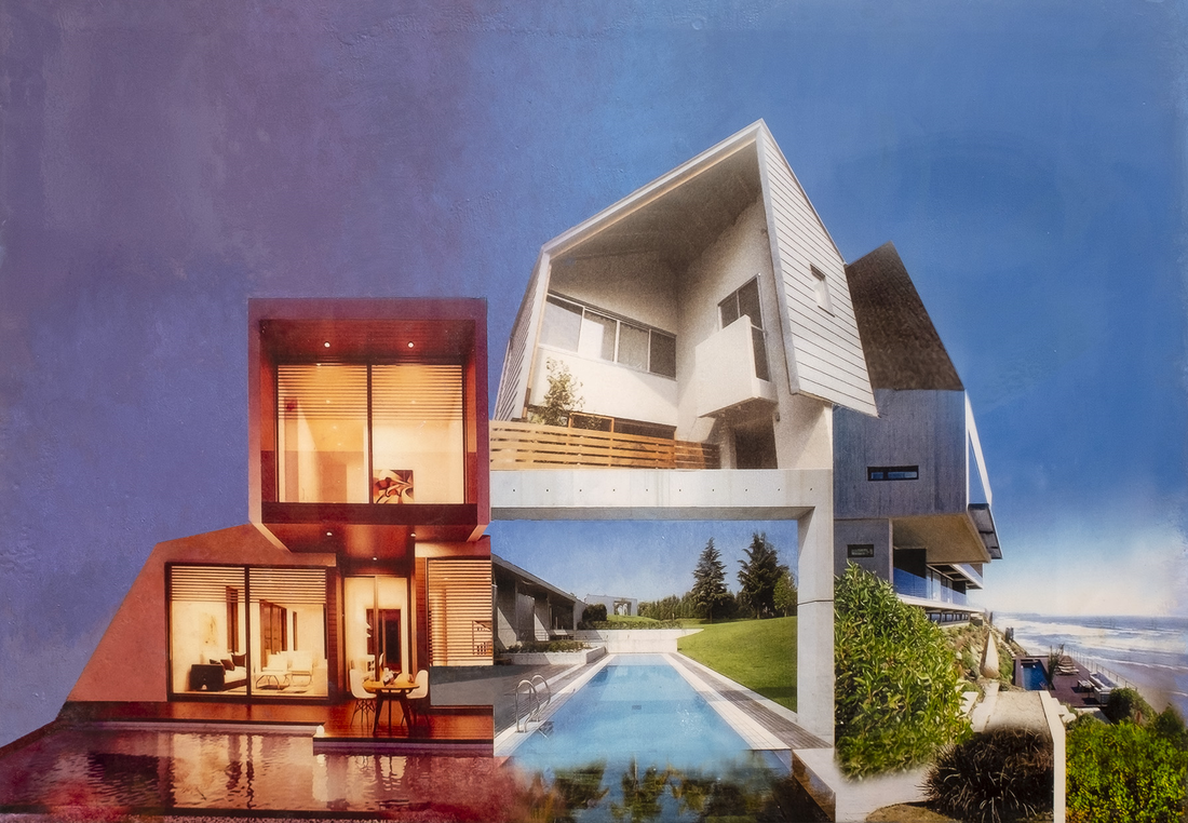Brian Ord
Seaview - Digital Print, Oil Paint & Resin, on Canvas, from Collage
70 x 100 cm - £1,620.00
‘Life is a dream, keeping us from sleep’ Oscar Wilde
The phrase ‘Impossible Interiors & Exteriors’ attempts to describe the nature of my most recent work.
This two-dimensional work has evolved in recent years from decades of my sculptural activity.
The works originate as small-scale hand-worked collages, appropriated from a wide variety of printed & online sources.
These collages are then photographed at high definition & digitally printed directly onto canvas, usually larger than the original.
The canvases are then worked over & evolved using epoxy resin & oil paint.
The original starting material often involves recent architectural imagery or household interiors of various kinds.
The illusionistic end products attempt to comment on issues involving the contemporary house & home and are, in particular, a political comment on the futile pursuit of domestic perfection.
They are influenced by early renaissance paintings, with their imperfect attempts at perspective. They also attempt to draw comparisons with this genre & the distortions now created by the over-efficient use of modern wide-angled camera lenses.
The work is influenced by cinema as much as it is by photography, sometimes echoing the shape of the screen via the canvas. Some of the titles & imagery also reflect this.
Recently, more specifically, they have also involved hotels, referencing similar escapist fantasies to the domestic interiors.
70 x 100 cm - £1,620.00
‘Life is a dream, keeping us from sleep’ Oscar Wilde
The phrase ‘Impossible Interiors & Exteriors’ attempts to describe the nature of my most recent work.
This two-dimensional work has evolved in recent years from decades of my sculptural activity.
The works originate as small-scale hand-worked collages, appropriated from a wide variety of printed & online sources.
These collages are then photographed at high definition & digitally printed directly onto canvas, usually larger than the original.
The canvases are then worked over & evolved using epoxy resin & oil paint.
The original starting material often involves recent architectural imagery or household interiors of various kinds.
The illusionistic end products attempt to comment on issues involving the contemporary house & home and are, in particular, a political comment on the futile pursuit of domestic perfection.
They are influenced by early renaissance paintings, with their imperfect attempts at perspective. They also attempt to draw comparisons with this genre & the distortions now created by the over-efficient use of modern wide-angled camera lenses.
The work is influenced by cinema as much as it is by photography, sometimes echoing the shape of the screen via the canvas. Some of the titles & imagery also reflect this.
Recently, more specifically, they have also involved hotels, referencing similar escapist fantasies to the domestic interiors.
As the critic, David Thorp observed in his recent review of the American contemporary artist Sherrie Levine,
“Where is the artistry in the representation of a facsimile? It is the act of selection, in the moment of choice, in the significance of the act of the artist.”
Brian Ord’s work in both 2 and 3 dimensions has always been about appropriation.
Brian Ord works with the re-appropriation process in both two and three dimensions. The photographs & objects that Ord uses are rarely his own. He appropriates objects, images, cards and photographs from a variety of sources in the mass media or the public domain. Like Sherrie Levine, his reuse of this original material of others both subverts and recontextualises them.
For instance, the material on the canvases may have originally belonged to someone else, but he has made them his own via a convoluted process of restructuring involving various materials and processes. This experience highlights the significance of the re-appropriation process to the artworks themselves, as well as commenting on the hidden significance of the original material involved.
While the sculptures utilise carefully chosen ready-made objects, the new paintings rely on similar appropriated photographic imagery. Originally made from paper collages, they are then digitally printed onto canvas before being transformed using oil paint & polyester resin.
“Where is the artistry in the representation of a facsimile? It is the act of selection, in the moment of choice, in the significance of the act of the artist.”
Brian Ord’s work in both 2 and 3 dimensions has always been about appropriation.
Brian Ord works with the re-appropriation process in both two and three dimensions. The photographs & objects that Ord uses are rarely his own. He appropriates objects, images, cards and photographs from a variety of sources in the mass media or the public domain. Like Sherrie Levine, his reuse of this original material of others both subverts and recontextualises them.
For instance, the material on the canvases may have originally belonged to someone else, but he has made them his own via a convoluted process of restructuring involving various materials and processes. This experience highlights the significance of the re-appropriation process to the artworks themselves, as well as commenting on the hidden significance of the original material involved.
While the sculptures utilise carefully chosen ready-made objects, the new paintings rely on similar appropriated photographic imagery. Originally made from paper collages, they are then digitally printed onto canvas before being transformed using oil paint & polyester resin.

